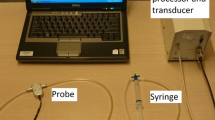Abstract
The objective of this study was to investigate the effect of lying and sitting positions on urodynamic parameters and diagnoses. This prospective study was carried out on 96 women with urinary incontinence who underwent urodynamic assessment. Cystometry was performed both in the lying and sitting positions. For filling cystometry, we infused normal saline at a rate of 50 ml/min. All the results were entered on the urodynamic database and were analysed using Minitab software release 13.30. Mean age was 49 (20–84) years. Sixty-four (67%) women complained of mixed incontinence, 16 (17%) of urgency alone, eight (8%) of stress incontinence and eight (8%) of urgency and urge incontinence. Two (2%) showed stress incontinence by lying cystometry, and 53 (55%) by sitting cystometry. During lying nine (9%) demonstrated detrusor overactivity, while 53 (55%) demonstrated detrusor overactivity in sitting position. No case of mixed incontinence was diagnosed by lying cystometry but 17 (18%) cases were detected by sitting cystometry. This study explains the higher detection rate of stress incontinence, detrusor overactivity and mixed incontinence by cystometry in sitting position. Therefore, we recommend that sitting posture is preferred over lying position for performing cystometry.
Similar content being viewed by others
References
Godec CJ, Cass AS (1980) Cystometric variations during postural changes and functional electric stimulation of the pelvic floor muscles. J Urol 123:722–725
Arnold EP (1974) Cystometry-postural effects in incontinent women. Urol Int 29:185–186
Abrams P, Cardozo L, Khary S, Wein A (2002) Evaluation and treatment of urinary incontinence, pelvic organ prolapse and faecal incontinence: recommendations of the international scientific committee, 2nd international consultation on incontinence July 1–3, 2001. 2nd edn. pp 1079–1116
Abrams P, Blaivas JG, Stanton SL, Andersen JT (1988) The standardisation of terminology of lower urinary tract function. The International Continence Society Committee on Standardisation of Terminology. Scand J Urol Nephrol Suppl 114:5–19
Warwick RT (1975) Some clinical aspects of detrusor dysfunction. J Urol 133:539–544
Mayo ME (1978) Detrusor hyperreflexia: the effect of posture and pelvic floor activity. J Urol 119:635–636
Choe JM, Gallo ML, Staskin DR (1999) A provocative maneuver to elicit cystometric instability: measuring instability at maximum infusion. J Urol 161:1541–1544
Blaivas JG, Groutz A, Verhaaren M (2001) Does the method of cystometry affect the incidence of involuntary detrusor contractions? A prospective randomised urodynamic study. Neurourol Urodyn 20:141–145
Fonda D, Brimage PJ, Brimage PJ, D’Astoli M (1993) Simple screening for urinary incontinence in the elderly: comparison simple and multichannel cystomery. Urology 42:536–540
Sutherst JR, Brown MC (1984) Comparison of single and multichannel cystomery in diagnosing bladder instability. Brit Med J 288:1720–1722
Sand PK, Brubaker LT, Novak T (1991) Standing incremental cystomery as a screening method for detrusor instability. Obst Gynec 77:453–457
Weprin SA, Zuspan FP (1980) The standing cystometrogram. Am J Obste Gynecol 138:369–373
Author information
Authors and Affiliations
Corresponding author
Additional information
Editorial Comment: With the value of urodynamic investigations under debate (see Glazener and Lapitan, Cochrane Library, Issue 1, 2004), it is helpful to evaluate the parameters for performing this technique. Even though the position of the investigation has been discussed for more than 20 years, it seems important to bear in mind the limitations of making simplifications for the investigator and providing more comfort for the patient. Only a few women with urinary incontinence complain of urinary loss in lying position; in order to achieve a high correlation between subjective complaints and urodynamic findings, it is important to perform the investigation under “ everyday conditions”, which at the very least means in a more up-right position. The authors should be encouraged to continue with a larger trial in which people are randomly allocated to management according to urodynamic findings.
Rights and permissions
About this article
Cite this article
Arunkalaivanan, A.S., Mahomoud, S. & Howell, M. Does posture affect cystometric parameters and diagnoses?. Int Urogynecol J 15, 422–424 (2004). https://doi.org/10.1007/s00192-004-1195-z
Received:
Accepted:
Published:
Issue Date:
DOI: https://doi.org/10.1007/s00192-004-1195-z




